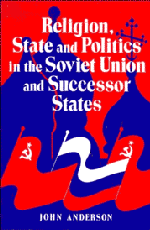Book contents
- Frontmatter
- Contents
- Acknowledgements
- 1 Introduction
- 2 Khrushchev: Towards a new assault
- 3 Khrushchev: Theory into practice
- 4 Brezhnev: Facing up to new challenges
- 5 Brezhnev and after: Combatting religion
- 6 Gorbachev and the liberalisation of religious policy
- 7 Religion, state and politics into the 1990s
- 8 Conclusion
- Bibliography
- Index
7 - Religion, state and politics into the 1990s
Published online by Cambridge University Press: 26 January 2010
- Frontmatter
- Contents
- Acknowledgements
- 1 Introduction
- 2 Khrushchev: Towards a new assault
- 3 Khrushchev: Theory into practice
- 4 Brezhnev: Facing up to new challenges
- 5 Brezhnev and after: Combatting religion
- 6 Gorbachev and the liberalisation of religious policy
- 7 Religion, state and politics into the 1990s
- 8 Conclusion
- Bibliography
- Index
Summary
The collapse of the Soviet Union in late 1991 completed the fragmentation of religious policy, and left religious groups in fifteen different states each with their own ideas on how to handle religion. Religious communities faced a new set of problems as they sought to come to terms with their pasts, with political and social pluralism, and with the challenges of operating in a freer environment. Whilst religion–state problems remained in some areas, there were also a growing number of inter-religious conflicts often closely linked to nationality tensions coming to the fore. And in the political arena religious bodies had to decide how best to use their resources and influence in a situation where many appealed to them for support. This chapter explores how, in the transition from Soviet republics to independent states, with varying degrees of success religious groups came to a new modus vivendi with the political authorities.
Religion's response to change
Internal reform
For many years religious activists had charged that the leadership of religious organisations compromised too much with the state authorities. After 1985 such claims were magnified, particularly when cautious leaders responded slowly to the possibilities provided by perestroika. Reform movements sprang up within a number of religious communities often, though not always, initiated by former dissidents. In Latvia, for example, the ‘Rebirth and Renewal’ movement succeeded in unseating the Lutheran establishment at a general synod in early 1989, and the new leadership promptly entered the political arena by calling for the ‘annulment of the Molotov–Ribbentrop pact, self-determination and Latvian independence’.
- Type
- Chapter
- Information
- Publisher: Cambridge University PressPrint publication year: 1994



